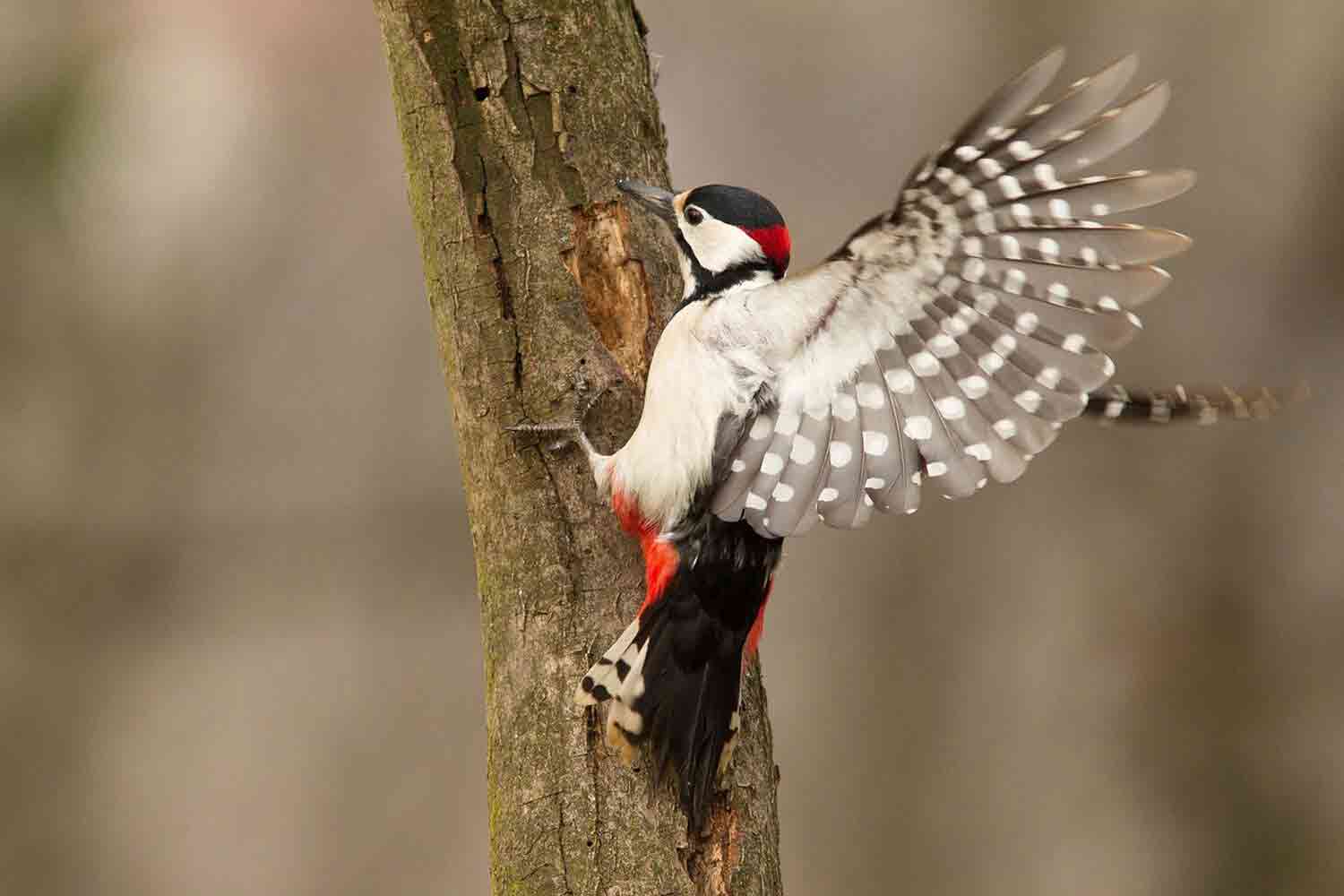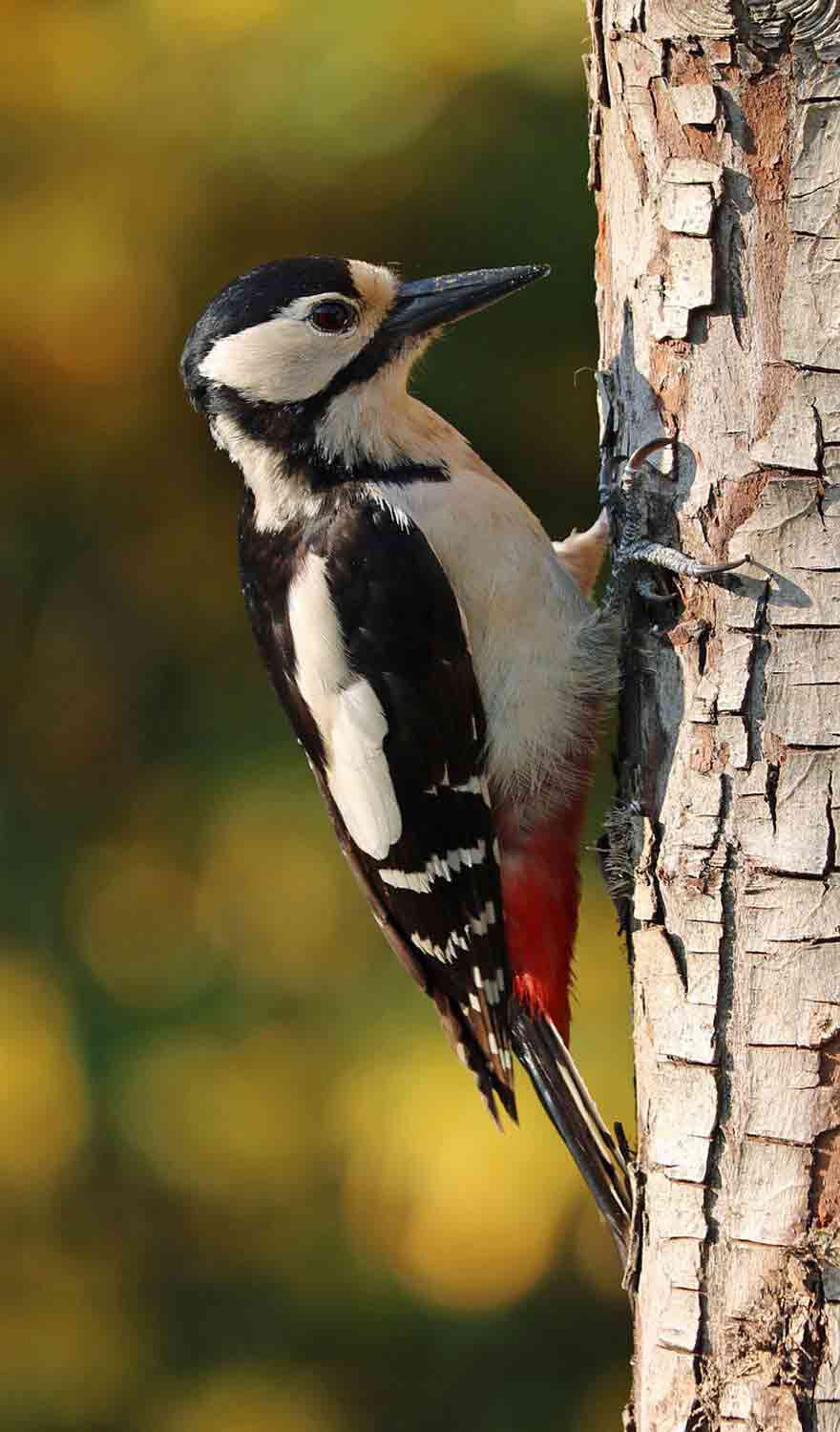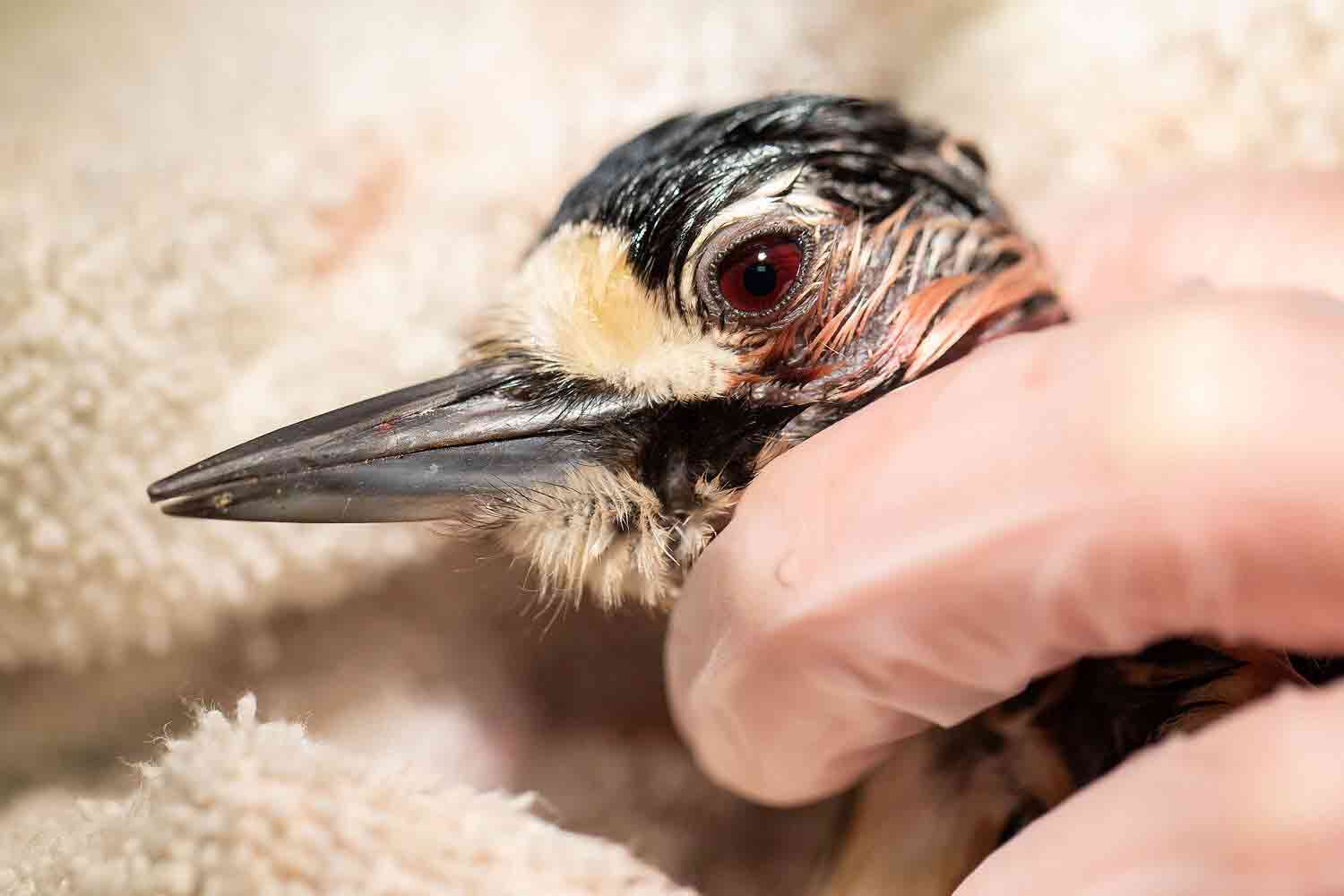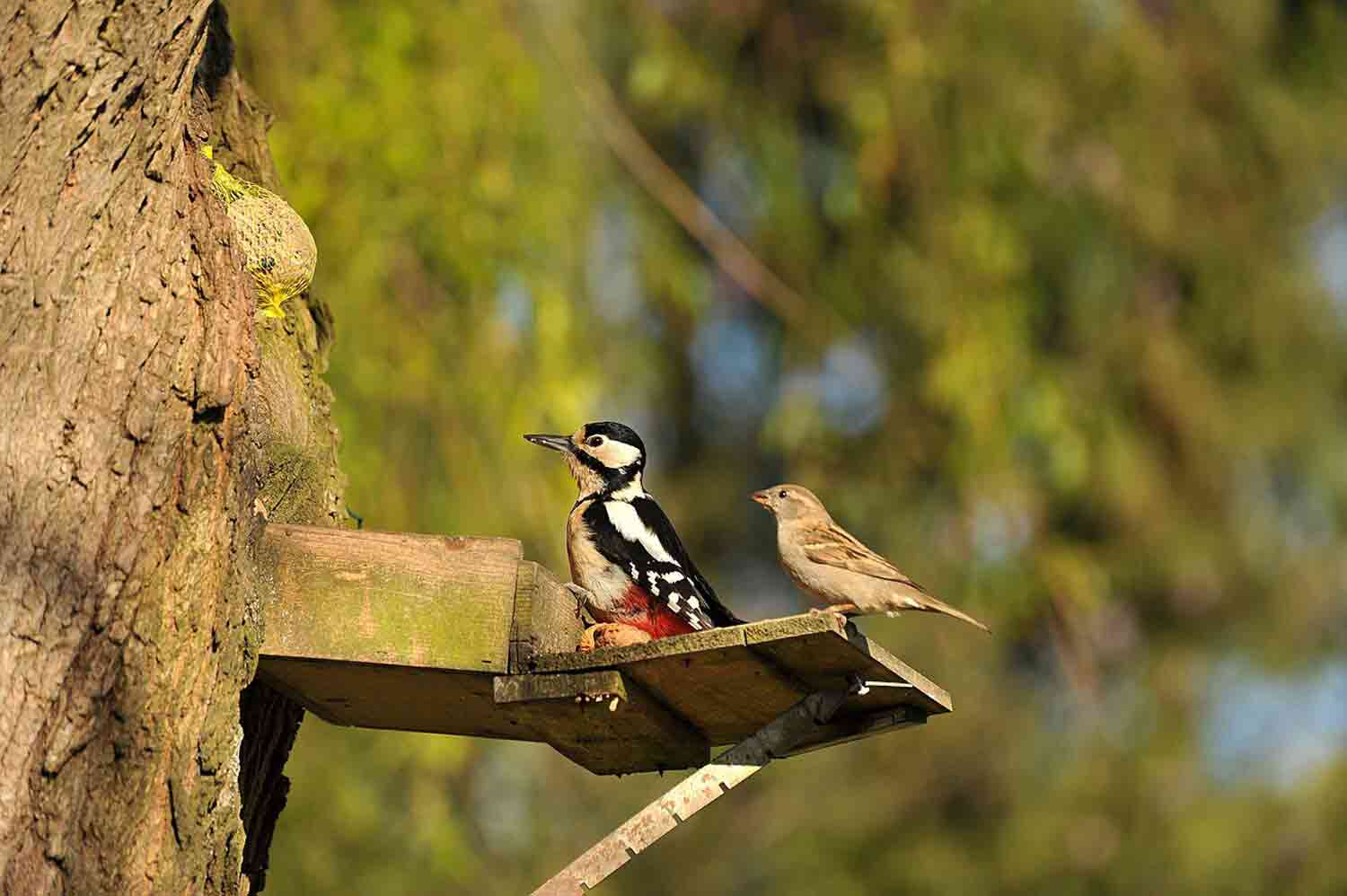Great Spotted Woodpecker
Dendrocopos major
Life History
Length: 21cm to 26cm
Wingspan: 34 to 38cm
Weight: 70 to 98g
Diet: Insectivore – insects, seeds and occasionally birds eggs and young chicks, especially during the breeding season. In winter, they will often feed or garden feeders.
Average Lifespan: 2 years, but oldest recorded was 11 years
When to see them: All year round
UK population: est. 140,000 breeding pairs
UK conservation status: Green

About
The Great Spotted Woodpecker isn’t shy about making noise—it’s well-equipped to thrive in the forest! With a powerful beak and a skull that absorbs shock, this bird is a true expert at chiseling into tree bark to find food and carve out its nesting space. Its adaptations make it a specialist in woodland life, perfectly suited for a life spent scaling trees and echoing its drumming call throughout the woods. Great spotted woodpeckers have striking white cheeks marked with a black stripe beneath and a bold black cap. Males have a bright red spot on the back of their head, which is a quick identifier.
One curious detail about great spotted woodpeckers is their impressively long tongues—so long, in fact, that when not in use, it wraps around the inside of the skull! It’s as if they have their own “tongue belt” for safekeeping while they’re on the hunt for insects.
Behaviour
The great spotted woodpecker is known for its loud drumming, used to mark territory and attract mates. It forages by chiseling into tree bark for insects, with a long, sticky tongue to catch prey in crevices. They are generally solitary and territorial, especially around nesting areas. They may defend these areas fiercely, especially in the breeding season. Their bold, active presence makes them an unmistakable part of the woodland soundscape.


Their Threats
Habitat Loss: As woodlands are cleared for agriculture, urban expansion, or logging, these birds lose vital nesting and foraging sites. They rely on mature trees to create cavities for nesting, which are increasingly scarce in some areas.
Climate Change: Climate change affects the availability and timing of food sources, especially during breeding seasons. Warmer winters and earlier springs can lead to mismatches between food supply (such as insect larvae) and chick-rearing periods.
Food Scarcity: Woodpeckers depend largely on insects and larvae found in woodlands. When insect populations decline due to pesticide use or loss of undergrowth, woodpeckers may struggle to find enough food, particularly during colder months when alternative sources are limited.
Competition with Other Species: The availability of nesting sites is limited, and woodpeckers often compete with other cavity-nesters, such as starlings and squirrels, which can disrupt nesting or cause abandonment of nesting sites.
How you can help
There are a number of simple ways you can help woodpeckers:
- Plant Native Trees: Supporting native woodlands by planting trees such as oak, beech, and birch can provide long-term nesting sites and increase insect habitats for woodpeckers.
- Limit Pesticide Use: Avoid pesticides in gardens to maintain a healthy insect population, which is essential for woodpecker foraging. Instead, encourage natural pest control by planting a variety of flowers and shrubs that attract beneficial insects.
- Install Nest Boxes: Providing nest boxes designed for woodpeckers (with thick walls and appropriate entry holes) can create alternative nesting options, especially in areas lacking old or dead trees.
- Support Woodland Conservation: Join or support local conservation groups that work to protect woodlands and natural habitats from deforestation and urban development, helping to preserve crucial habitats for the woodpecker and other wildlife by signing this petition.
- Observe Cautiously: If you spot a woodpecker’s nest, maintain a respectful distance to avoid disturbing their breeding and foraging activities.

Frequently Asked Questions
Why do woodpeckers peck on trees, and doesn't it hurt them?
Woodpeckers peck at trees primarily for three reasons: to find food (like insects hiding in the bark), to communicate (often as a territorial signal), and to create nesting cavities. They have evolved specialized adaptations, such as shock-absorbing skulls and a unique arrangement of muscles that cushion the impact, preventing injury from the repetitive pecking.
I have a woodpecker pecking at my house, what should I do?
You can place aluminum foil or flashing over the woodpecker’s excavation site to deter further excavation. This solution also prevents incessant drumming, as woodpeckers generally don’t like shiny objects.
You can also try hanging mirrors or sticking mylar tape near the area. Other reflective options that drive woodpeckers away include shiny helium balloons and reflective streamers. If you have old music CDs, create a mobile using these shiny discs.
I think I've found an orphaned woodpecker
You should only take baby birds into captivity as a last resort if:
- They’re sick or injured
- You know for sure that the parents are dead
- You’ve continuously monitored from a distance for more than two hours and the parents haven’t returned
In these cases, you should contact your local wildlife rehabilitation centre or vet as soon as possible. Our emergency helpline is 01372 360404.
** Be aware of the power of their beak**
Are woodpeckers at risk from predators like cats?
Yes, woodpeckers can be vulnerable to predation by cats, especially when foraging near the ground or at bird feeders. To minimize risk, placing bird feeders higher off the ground can help protect woodpeckers and other birds from unnecessary predation.
A woodpecker starts nesting under my roof, can I remove it?
Under the Wildlife & Countryside Act 1981 (WCA, the primary legislation which protects animals, plants and habitats in the UK) it is:
- ‘an offence intentionally to kill, injure or take any wild bird, or take or destroy their eggs or nest, or damage a nest, while that nest is in use or being built’.
- It is also illegal to deliberately block access to a nest by, for example, stopping birds entering your roof to get to an active nest.
With some exceptions, you can remove nests as long as they’re not being built or in use. However, please keep in mind that some species will have more than one brood in the same nest in a given season. What’s more, unless there’s a reason to remove the nest, leaving it alone can be beneficial for wild birds.